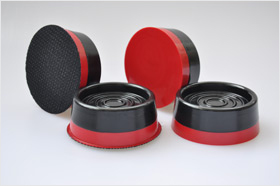What is the Tan Delta for Damping Material?
Tan delta

What is the tan delta for damping material? Tan delta is an abbreviated form of the term—Tangent of Delta. The tan delta quantifies the way in which a material absorbs and disperses energy. It expresses the out-of-phase time relationship between an impact force and the resultant force that is transmitted to the supporting body. Materials that effect the greatest phase shifts—approaching 90 degrees—have the highest tan delta values. These materials demonstrate the greatest capability to dissipate energy in a safe form—such as heat—at as close to 90 degrees (perpendicular) to the impact surface as possible. The tan delta is also known as the Loss Factor due to this loss of energy from the impact force via conversion to, and dispersal of, a safer form of energy. Thus, the tan delta is ultimately an indication of the effectiveness of a material’s damping capabilities. The higher the tan delta, the greater the damping coefficient, the more efficient the material will be in effectively accomplishing energy absorption and dispersal.
Damping
The absorption and safe dispersal of energy is known as damping. As a result of the damping process, energy is converted to safer levels or frequencies.
Damaging effects of impact and damping
-
- The transfer of energy that originates from an impact force (shock, vibration, noise) can result in injury or damage.
-
- Undesirable energy transfer will ultimately cause inefficiencies such as product and material waste, rework, and process downtime.
-
- The harmful effects of impact force can be counteracted by employing a methodology for safely and effectively absorbing impact energy. This is achieved with the use of a good damping material. To accomplish this, you need to know—just what is the tan delta for damping material? The tan delta, or damping coefficient, indicates the ability of a material to absorb and disperse energy. Sorbothane® is the most efficient material currently available for energy absorption. This, coupled with the ability of Sorbothane to safely efficiently disperse energy, makes it the best damper on the market.
What is Sorbothane, and what makes it an effective damper?
-
- Sorbothane is a proprietary polymer—a polyether-based polyurethane material.
-
- Sorbothane is a castable polymeric material. This polymer possesses viscoelastic traits—traits of a solid as well as a liquid.
-
- When Sorbothane experiences the impact of a force, it flows just like a liquid (viscous solution).
-
- Once the impact force is removed, Sorbothane is returned to its original shape—displaying a characteristic of an elastic solid.
-
- Sorbothane takes absorbed energy and safely disperses it perpendicular to the source in the form of heat.
-
- Sorbothane displays a superior damping coefficient. This material is effective across a broad temperature range and displays chemical resistance properties. Globally, engineers specify Sorbothane as a superior damping material.
Addressing your damping needs with Sorbothane

Sorbothane has created a line of products that provide superior damping ability, including:
-
- Pallet Isolation Rings.
-
- Anti-vibration glove palm pads.
-
- Bushings, Grommets, and Washers.
-
- Strips and Sheet Stock for unique applications.
Are you interested in learning how Sorbothane can assist with your specific damping needs? Sorbothane’s engineering experts are ready to help. Request a free quote.